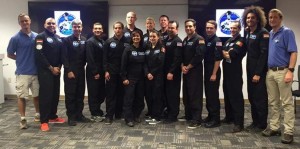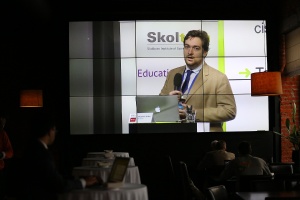Skoltech students and graduates, AKA “Skoltech Martians 2.0″, are going to defend their project of a two-person flyby past the “Red Planet”, at the international competition of students’ works, organized by The Mars Society.
Skoltech is an international graduate research-focused university that was founded by the group of world-renowned scientists in 2011. Skoltech's curriculum focuses on technology and innovation, offering Master's programs in 11 technological disciplines. Students receive rigorous theoretical and practical training, design their own research projects, participate in internships and gain entrepreneurial skills in English. The faculty is comprised of current researchers with international accreditation and achievements.
Tag Archives: марс
From NASA to Skoltech and back
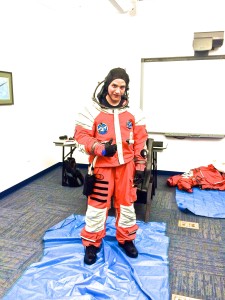 “I came to Skoltech because I wanted to do cooperation between the U.S. and Russia in the space sector” says Axel Garcia, a student in the Skoltech Space Center. Garcia is an example for the international-innovative-entrepreneurial nature of Skoltech. Originally from Puerto Rico, growing up in Florida, at the age of 23, Garcia already worked at NASA as an electrical engineer, received a Master’s degree from EPF Graduate School of engineering in France, and currently working on his second Master thesis in Skoltech.
“I came to Skoltech because I wanted to do cooperation between the U.S. and Russia in the space sector” says Axel Garcia, a student in the Skoltech Space Center. Garcia is an example for the international-innovative-entrepreneurial nature of Skoltech. Originally from Puerto Rico, growing up in Florida, at the age of 23, Garcia already worked at NASA as an electrical engineer, received a Master’s degree from EPF Graduate School of engineering in France, and currently working on his second Master thesis in Skoltech.
Recently Garcia went back to NASA, but not because of his work engagements there. He was one of the selected few to participate in the PoSSUM project, a non-profit suborbital research and education program devoted to the study of our upper atmosphere and the role it plays in the understanding of our global climate, held at the Embry-Riddle Aeronautical University in Daytona Beach, FL. We asked Garcia to tell us about this unique experience, and its connection to his cooperation aspirations.
Q: how did you manage to get the invitation to the program?
A: I had to apply, to write an essay and do an interview. It was a competitive thing. We have been taking courses remotely, two months before the project.
A: I was with a group of PhD students, from Egypt, Canada, the US, Portugal, Australia and India. They were all really smart, and they all wanted to become astronauts, so it was like a competition. For me the most amazing thing was to be with all these people. They were all scholars, and they all motivated me to keep into this program.
Q: What did you do during this part of the program?
A: Mostly it was how to perform science in the upper atmosphere. We were trained to go to space in commercial space flights in the future, and so we could be qualified to be the ones manipulating all the equipment and all the cameras, to do this tomography science – measuring clouds, to see how space weather is changing and so on. We had different equipment, we did aerobatic flights, and we experienced micro-gravity.
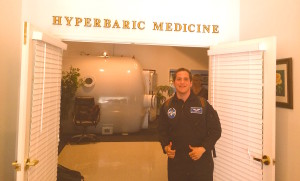 We also went into a hyperbaric chamber, which simulates the effects of high altitude on the human body. When you go up the pressure increases, and you’re not getting oxygen into your system, so people kind of faint and feel funny. Sometimes they start laughing without a reason. We were trying to see how our body is affected by this, if we can actually go through this hypoxia.
We also went into a hyperbaric chamber, which simulates the effects of high altitude on the human body. When you go up the pressure increases, and you’re not getting oxygen into your system, so people kind of faint and feel funny. Sometimes they start laughing without a reason. We were trying to see how our body is affected by this, if we can actually go through this hypoxia.
We also had a lot of courses about the atmosphere, about science, how to do analysis in the atmosphere, because we were training to become scientist astronauts, not pilots. In the end, naturally, we had a test.
Q: So you want to be an astronaut?
A: Yes! This program gave me qualification to become a scientist astronaut in the future. Not a NASA astronaut, but a commercial space flight astronaut for either Virgin Galactic or other private companies. My title now is “Astronaut candidate”, because I’m qualified to do the assignments they will need to do in the future in these private flights. I’m not an astronaut yet, I guess I will apply in the future.
But I also have this entrepreneurship spirit, and I want to make collaboration between the two countries. I believe that to achieve higher – to go to the moon again, to go to Mars – we need to collaborate together. It’s really expensive to go to space, so you really need to get organized and divide the work to different people.
Q: How do you connect this with the PoSSUM program?
A: One of the reasons I went there is because of Skoltech. I went to learn there about the equipment and to understand all the training that these astronauts go through, so that the entrepreneurship project I’m working with Prof. Rupert Gerzer now will become possible. We want to bring this mentality and these training activities into Russia.
Q: what can you tell us about this project?
A: I am very interested in human space flights and sub-orbital flights (a flight that you go into space for five minutes), which I think a lot of people are interested in, as tourists. We are trying to commercialize the training, to make a facility that many people can use to train like an astronaut. People who want to do parabolic flights and orbital flights, can use this facility to do their training with us. It will be cheaper for them.
Space cooperation can bridge any political crisis, ESA head tells Skoltech students
The Moon Village – a permanent lunar base station – should be a truly international affair, and Russian villagers are more than welcome, European Space Agency head Johann-Dietrich Woerner told Skoltech professors and students on Friday during a Skype lecture devoted to his lunar dream.
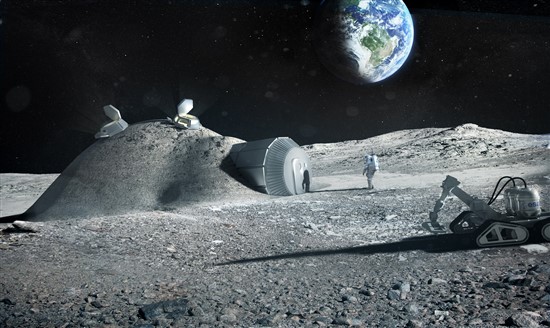
Radiation shelters for residents of the Moon Village are planned to be made from lunar resources. Photo: ESA.
The Moon Village is still very much a concept rather than a project at this stage, Woerner stressed, but nonetheless, the vision of the project is not without details.
The best location for the Moon Village is on the natural satellite’s South Pole, as there is water there and areas of permanent light, and the village structures will have to be made from the resources available on the moon, he said, speaking from Germany.
“The radiation there is very strong, so we will need to build structures, and they should not be sent from Earth. We should build them there using the materials available and 3D printing, producing radiation shelters for the astronauts. We cannot take all the stuff there – that’s in the past. We need to use the materials and resources that are there,” he emphasised.
The mission to the moon should combine human and robotic work, have multiple missions and purposes, and it should be a springboard for future deep space travel, said Woerner, a German civil engineer who has headed the agency since July 2015.
“Moon science is underdeveloped,” he said, adding that lunar tourism and commercial mining would also be possibilities offered by the Moon Village.
Stepping stone to Mars
While in recent months, missions to Mars – both real and imaginary – have been the focus of attention, the Moon Village would be a crucial first step toward making manned missions to Mars a reality, Woerner said.
“We are on our way to Mars right now with Russia, to look for life there,” he said, referring to ExoMars, a joint mission between the ESA and Roscosmos, Russia’s state space corporation, which launched an orbiter and lander from Baikonur on March 14 to collect data on the Martian atmosphere. “But it will take seven months to get there, and to come back, the whole journey is about two years,” he said.
“That’s OK for a robot, but think about humans: If someone becomes ill on their way to Mars, there’s no way to come home earlier. To go to the moon and back takes one week. We need to start with the moon, not go directly to Mars.
“America is planning its journey to Mars, but they know they can’t get there for 20-30 years. The Moon Village is the perfect stepping stone,” he said.
This week, Roscosmos said it planned to build its own research center on the moon by 2035, and said a location had already been chosen on the edge of a crater.
Lin Industrial, a private Russian space startup and resident company of the Skolkovo’s space cluster, said last year that it could build a lunar base for 550 million rubles ($8.2 million) – also at the moon’s South Pole.
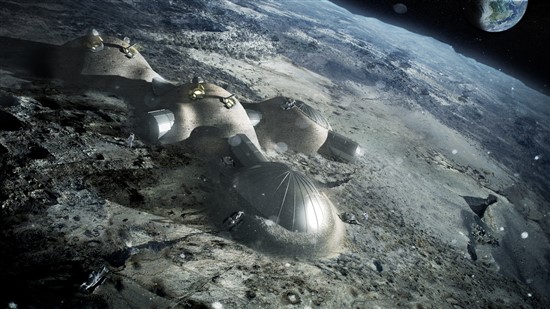
The Moon Village structures will be made using 3D-printing technology, the ESA head expects. Photo: ESA.
Space above politics
But Woerner is adamant that the most important thing is that different countries should work together on one unified project.
“No one should do it alone: it should be a joint project – that’s why it’s a village,” he said.
“This is what space can do,” he said, showing a photo of German astronaut Alexander Gerst, Russian cosmonaut Maxim Surayev and U.S. astronaut Gregory Wiseman waiting to take off for the International Space Station in May 2014, even as relations between the countries had plummeted at the height of the Crimean crisis.
“Even in times of crisis, we try to bridge the crisis,” said Woerner.
“Yesterday, we had the Space Race between the Soviet Union and the U.S. to get to the moon. We know the story: it was not focused on content, but on prestige. Today we’re in a totally different world,” he said.
His call for international cooperation was echoed by the representative of the ESA in Moscow, Rene Pischel, who was present in the lecture theater at Skoltech.
There are two main fields of cooperation between Russia and ESA: joint experiments on the ISS, and the ExoMars mission that recently launched from Baikonur, he said, adding that cooperation in space was strong despite international political tensions on Earth.
“Everybody is really trying to keep space out of the political equation. One reason is that space, as we have heard, is a bridge that we should use even during critical situations. The other is that space programs are very long-term, so if we always reacted to short-term political crises or difficulties, we wouldn’t get anywhere,” said Pischel.
The ESA is made up of 22 member states plus Canada.
The lecture was organised by Skoltech’s Space Center as part of Professor Rupert Gerzer’s course on Human Spaceflight.
Text by Shura Collinson, Sk.ru
Prof Golkar and Pres Crawley win Best Paper Award
The International Council on Systems Engineering (INCOSE) has selected a paper by Prof Alessandro Golkar and President Edward Crawley to receive the Systems Engineering journal’s 2014 Best Paper of the Year Award.
The paper, A Framework for Space Systems Architecture under Stakeholder Objectives Ambiguity proposes to integrate methods from systems engineering, computational systems architecting, multidisciplinary systems design and optimization, uncertainty modeling, utility theory, and social science research. It allows decision makers to visualize an architectural synthesis of aerospace systems, understanding negative impacts of ambiguity, and supporting negotiations among stakeholders for efficient compromise in systems architecting.
The award was announced at the INCOSE International Symposium IS 2015 in Seattle, coinciding with the event’s 25th Anniversary Edition.
Golkar, who heads Skoltech’s Strategic Innovation Research Group (SIRG) and only recently clinched the prestigious Luigi G. Napolitano Award thanked the journal’s editorial board. “I am delighted by this award and the recognition from INCOSE”, said the Italian born Skoltech researcher whose team of researchers focuses in systems design for Space, Energy, and other applications, and concepts such as ‘space as a service’ and Federated Satellite Systems. “The Council serves a very important role in making an impact on the world with systems engineering practice. Together with my students, we are now working on developing systems engineering competency here at Skoltech. We hope to contribute more to INCOSE publications in the future.”
Interestingly, the paper, which uses a robotic Mars expedition as a demonstration, won the prize on the same day the New Horizons spacecraft flies by Pluto on the outer edge of the solar system.
Text: Ilan Goren Photo: Alexey Kalabin
May 29: Human Spaceflight – Skolkovo Spaceman Charts the Next Stage
Some people describe Sergey Zhukov as a test cosmonaut. Others relate to him as a leading expert on space exploration. Some even call him the Skolkovo Spaceman.
The Executive Director of the Space Technologies and Telecoms Cluster will be our guest speaker at professor Golkar’s class on Thursday, May 29. He will present his view on new approaches and challenges related to Human Spaceflight.
May 29th, 1.30-3pm
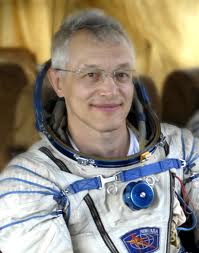
Sergey Zhukov, test cosmonaut, skolkovo space director and guest speaker
SPEAKER INTRODUCTION
